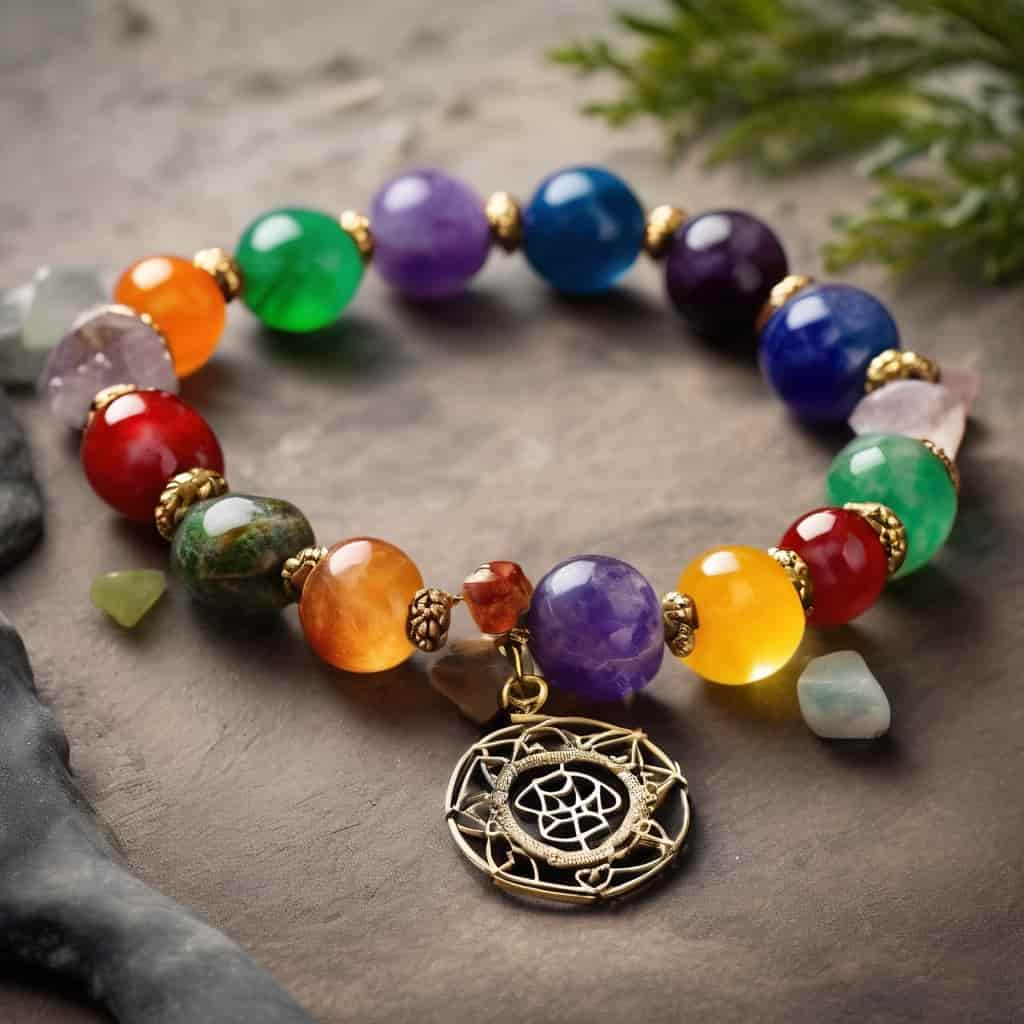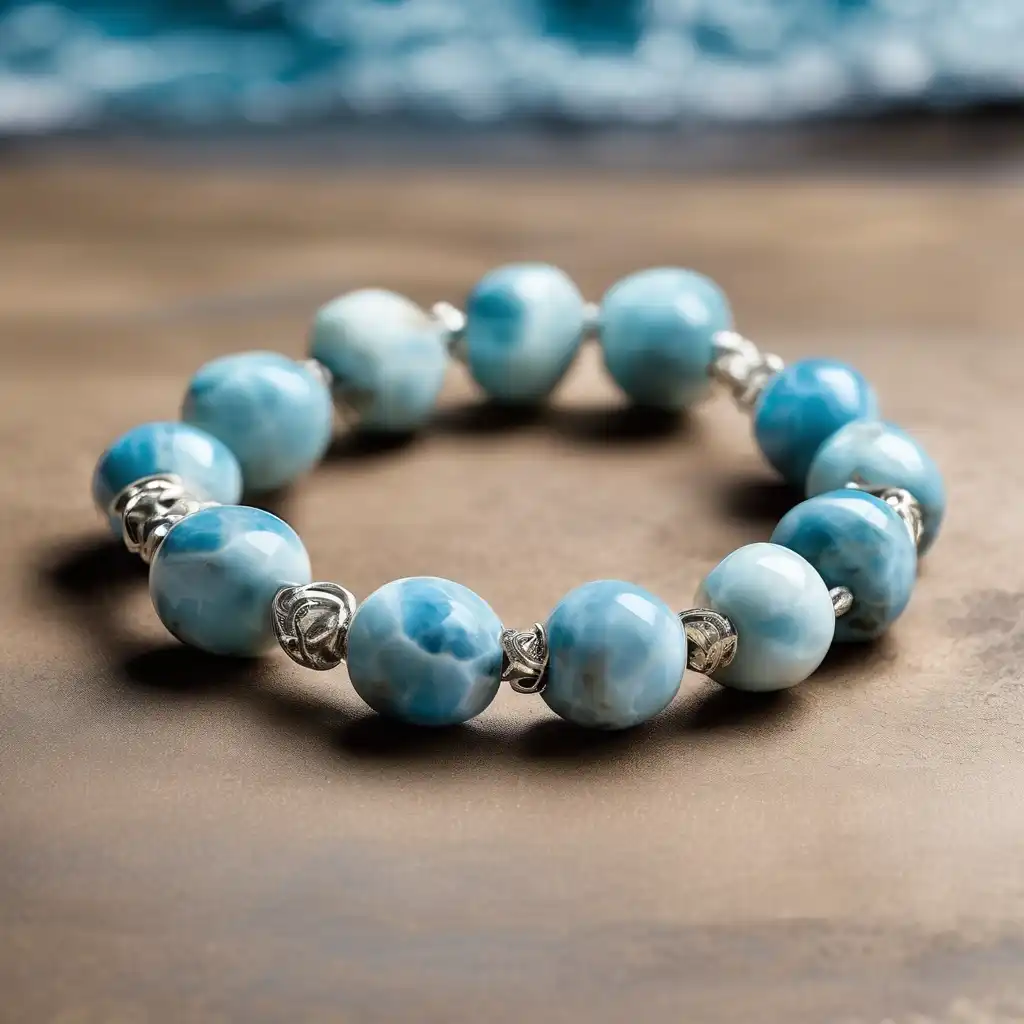Pearls Restrung: Everything You Need to Know Before Your Necklace Breaks
Why Pearl Necklaces Break and Why They Must Be Restrung
Thread Wears Out Long Before Pearls Do
Pearls may be forever, but the thread holding them together certainly isn’t. Whether your necklace was bought last year or handed down through three generations, its integrity depends on something surprisingly fragile—thread.
Over time, even high-quality silk or durable synthetics degrade. They rub against the edges of drilled pearl holes. They absorb sweat, perfume, humidity, and skin oils. Eventually, they weaken to the point of snapping. That’s why anyone who owns pearls long-term must consider getting their pearls restrung as essential—not optional.
Everyday Habits That Damage Your Necklace
You don’t have to be careless to wear out a necklace. Everyday routines are enough. Spritzing perfume after you’ve put your pearls on. Wearing them directly on bare skin during a hot day. Storing them hanging instead of laid flat.
All of these habits strain the thread holding those pearls together. The pearls may look pristine on the outside, but inside? The cord may already be fraying. If you’ve worn your strand for years without maintenance, chances are, it’s overdue for service.
Having your pearls restrung regularly is the only way to stay ahead of unseen wear.
A Break Happens When You Least Expect It
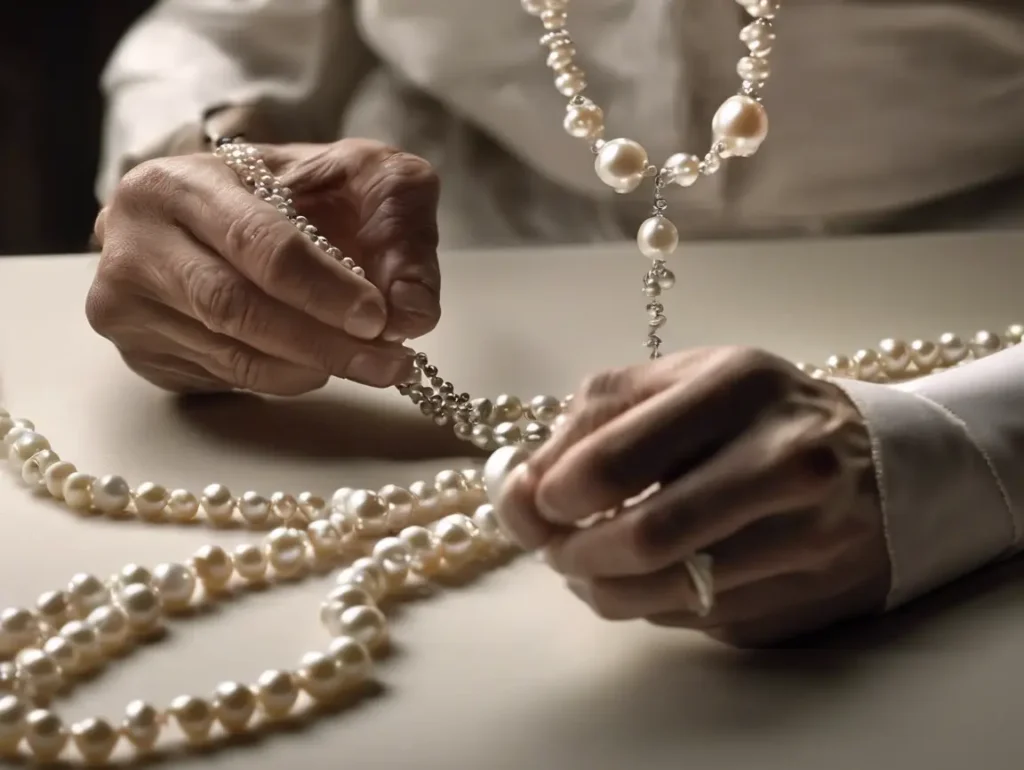
Ask anyone who’s ever had a pearl necklace break—it never happens when you’re at home, gently handling it. It always snaps at the worst possible moment: during a dinner party, in the middle of a speech, or right as you’re leaning over a sink.
And when it goes, it goes fast. A strand without knots spills every bead in every direction. Most are never recovered. But the tragedy isn’t just about the loss of pearls—it’s the emotional damage of watching something meaningful fall apart in seconds.
That’s why people who’ve had it happen once never wait again to have their pearls restrung.
Restringing Is Prevention, Not Just Repair
Too many people think of restringing only after disaster strikes. But the truth is, like dental cleanings or oil changes, it’s meant to be preventive. If you wear your pearls frequently—say, once a week—you should consider annual maintenance.
For occasional wearers, every two to three years might suffice. Still, regular inspection by a jeweler is a smart move. They’ll check for stretch, knot spacing, discoloration, and clasp security.
Restringing your pearls before they fail will always cost less—financially and emotionally—than waiting until it’s too late.
Knots Aren’t Just Pretty—They’re Protection
Let’s talk about those tiny knots between pearls. They’re not just decorative. They’re your last line of defense. A properly knotted strand ensures that if your necklace breaks, you’ll lose at most one pearl.
And there’s more: knots prevent the beads from grinding against one another. Without them, pearls can wear down, especially around the holes. That subtle spacing also gives the necklace its graceful drape and flexibility.
If your current strand isn’t knotted, talk to your jeweler. Most customers who switch never go back. It makes every set of pearls restrung stronger, more elegant, and far more secure.
Length Loss or Gain After Restringing
One thing surprises people: their necklace might come back shorter or longer after being restrung. If your strand was previously knotted but loose from wear, a fresh, tight re-knotting will pull the pearls closer together, shortening the strand slightly.
On the flip side, if your necklace wasn’t knotted before and you now add knots, you might gain up to an inch or more in total length. Neither result is bad—it’s just physics. The key is communication.
Let your jeweler know your ideal fit. A well-done restringing gives your pearls a new structure while still matching your preferences.
Don’t Let Sentimental Value Shatter on the Floor
Sometimes it’s not about money at all. Maybe it’s your grandmother’s necklace. Maybe it’s what you wore on your wedding day. Maybe it’s the gift your partner gave you when your child was born.
The value isn’t in the appraised price—it’s in the memories. That’s exactly why the smartest way to honor that value is to take care of the physical form.
Get your pearls restrung before they betray you at a moment when you’re not ready. Because once a pearl is lost—especially an old or unique one—it might never be replaced.
How Much Would It Cost to Get Pearls Restrung?
I’ve witnessed numerous affordable repairs that required a redo within months. It’s better to spend a little more and get it done right the first time.
There is no one price that fits all.
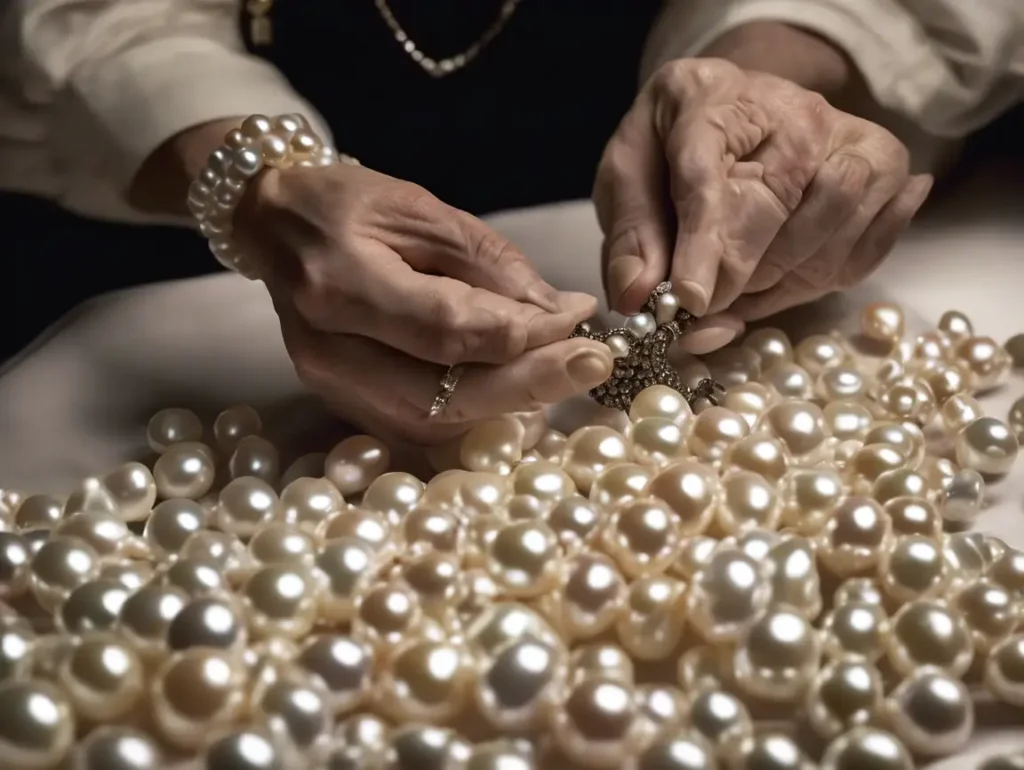
Ask five jewelers how much it costs to get your pearls restrung, and you’ll likely get five different answers. Why? The cost varies based on the type of pearls you bring in.
A short strand of freshwater pearls, gently worn and loosely knotted, might only cost $40 to fix. But a long double strand with worn silk, a stretched clasp, and uneven spacing? That could easily run you closer to $100 or more.
The materials, condition, labor, and complexity all matter.
The Knotting Factor
Knotting the strand is the single biggest factor that affects the cost. Knotted strands take longer—each pearl must be handled one by one, with tight, even spacing and consistency throughout.
It’s not just about time; it’s about touch. You want each knot to sit snugly beside the pearl without looking bulky or sloppy. That level of care requires experience.
So when you ask for your pearls restrung with knots, you’re not just paying for thread—you’re paying for precision and security.
Unknotted strands are quicker to string, which lowers the labor cost. However, while you save money, you risk losing durability. A break could result in the loss of all the pearls. Most professionals will recommend adding knots if your necklace didn’t have them originally, even if it bumps the price slightly.
Material Choices Can Shift the Price
Today, most professional stringers use either silk or high-quality nylon thread. Silk is soft and traditional, but it stretches and absorbs oils over time, making it less durable for frequent wear.
Nylon is stronger, moisture-resistant, and mimics the drape of silk, allowing for longer-lasting stringing results.
If your pearls are restrung with nylon, they may last longer between services—saving you money in the long run.
Unknotted strands are quicker to string, which lowers the labor cost. However, while you save money, you risk losing durability. A break could result in the loss of all the pearls.
Most professionals will recommend adding knots if your necklace didn’t have them originally, even if it bumps the price slightly.
Location and reputation matter
Where you live and who you trust with your jewelry will also affect pricing. A reputable jeweler in New York or London will charge more than a hobbyist in a small town.
But with rare or sentimental pieces, you get what you pay for. Someone with experience will restring the pearls and inspect each one, rebalance the strand, clean the clasp, and make sure the final piece drapes naturally.
Don’t be surprised if a specialist charges more to have your pearls restrung—they’re often repairing someone else’s earlier mistakes in the process.
Beware of the bargain job.
If you see a shop offering $20 restringing on all necklaces, ask questions. Are they using silk thread or a cheap plastic line? Are they knotting or not? Do they offer guarantees? Can you see examples of their work?
A poorly pearls restrung strand of pearls may feel too tight, too stiff, or break far sooner than it should. Worse, it may not protect your pearls at all.
I’ve witnessed numerous affordable repairs that required a redo within months. It’s better to spend a little more and get it done right the first time.
Can You Do It Yourself?
Technically, yes. There are kits out there with cord, needles, and video tutorials. But unless you’ve had practice, it’s surprisingly easy to mess up the tension, misalign the pearls, or tie knots that slip.
And if you damage the pearls while trying? That cost will far exceed what a pro would’ve charged. For most people, having their pearls restrung is a once-every-few-years task. It’s worth handing off to someone who does it every day.
So what’s the real range?
Here’s a basic rule of thumb:
- Standard single strand, knotted: $40–$70
- Double strand: $75–$120
- Vintage or complex work: $100 and up
Prices vary, but remember: you’re not just paying for thread. You’re paying for time, care, and the peace of knowing your necklace is strong again. - If your pearls restrung come back looking better than new, then it was money well spent.
- Standard single strand, knotted: $40–$70
- Double strand: $75–$120
- Vintage or complex work: $100 and up
Prices vary, but remember: you’re not just paying for thread. You’re paying for time, care, and the peace of knowing your necklace is strong again. If your pearls restrung come back looking better than new, then it was money well spent.
Should You Knot Your Pearls or Leave Them Loose?
The Purpose of Knots—It’s Not Just for Aesthetics
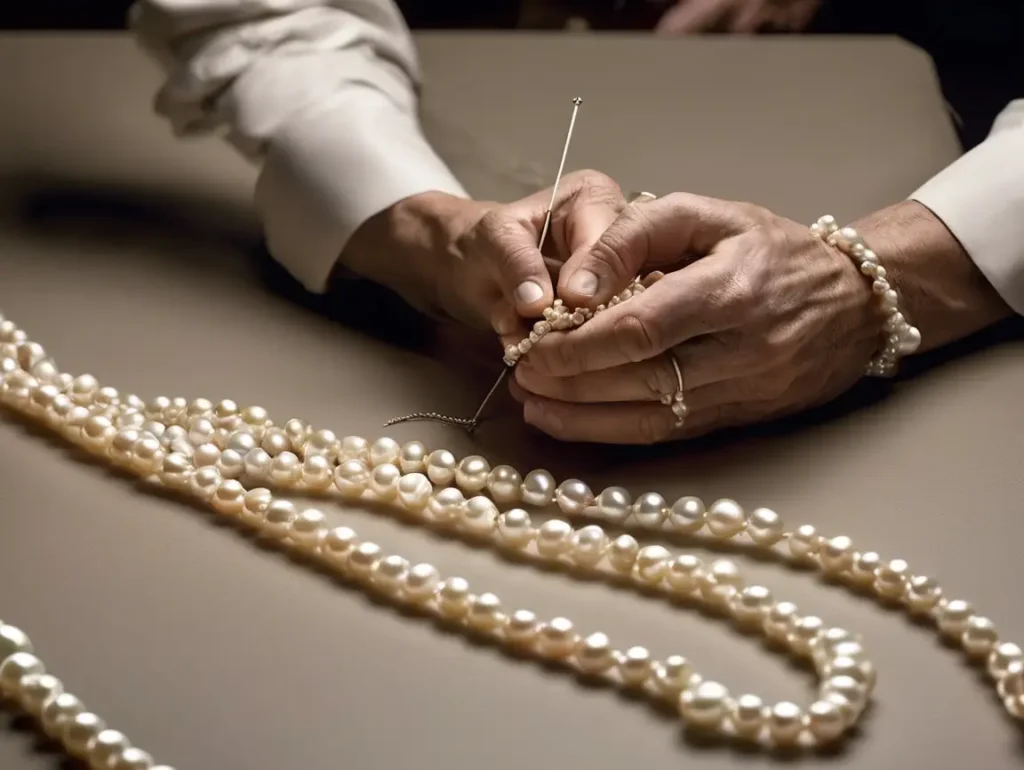
When someone sees a beautifully knotted pearl necklace, their first reaction is usually admiration. The spacing, the symmetry—it looks refined.
But the truth is, knots serve a far more practical purpose. If the thread breaks, knots keep the pearls from all falling off at once. You might lose one, maybe two—but not the whole strand.
That’s a big deal, especially when the pearls are vintage or have emotional value. When you have your pearls restrung, knots are not an afterthought. They’re part of the security system.
Knots Keep Pearls from Damaging Each Other
Pearls aren’t diamonds. They’re soft. If they rub against each other for too long, they begin to wear down—especially around the drill holes.
The surface can scratch or chip, and over time the necklace may lose its sheen. Knots act like cushions between each pearl. They prevent this kind of friction damage.
If your strand currently lacks knots and you are having your pearls restrung, please consider adding them. A little spacing now can mean decades of protection later.
Knots Affect the Way the Necklace falls.
Ever wear a strand of pearls and feel like it’s “off” somehow—twisting strangely or not sitting flush against your skin? The structure of knotting helps pearls line up evenly, creating a natural curve that drapes properly on your neckline.
A poorly knotted strand may look stiff or bumpy. A properly pearls restrung piece will flow like fabric. Isn’t it a graceful descent? It doesn’t happen by accident.
It’s the result of balance, tension, and spacing—done pearl by pearl.
But won’t knots shorten my necklace?
Yes—and no. If your original necklace was already knotted and has stretched over time, re-threading it may make it shorter. This is not a defect, it’s just the string being tightened again.
Conversely, if you haven’t tied a knot before and start knotting it now, it may end up being a little longer. Each knot adds a little more space.
That’s why you should always tell your jeweler your preferred final length when getting your pearls restrung. They can adjust the layout to match your style—whether you want a snug choker or something more relaxed.
Are There Any Situations Where You Shouldn’t Knot?
A few. Graduated strands—where the pearls change size gradually from front to back—can make knotting tricky.
Smaller pearls’ holes may be too tight for thicker thread and knots, necessitating occasional adjustments. And metal spacer beads with large holes? Knots can slip inside and disappear.
An experienced jeweler will know how to navigate these situations. But as a general rule, if you can knot your pearls, you should. A well-knotted strand is safer and more elegant and shows you care about the longevity of your jewelry.
It’s the kind of detail that distinguishes a generic necklace from one that’s been professionally pearls restrung.
What If You Don’t Like the Look of Knots?
Then talk to your jeweler about alternatives. Some people prefer the tight, bead-to-bead look of an unknotted strand, and that’s valid.
But you can compromise. There are micro-knotting techniques that create smaller, nearly invisible knots. Or you can knot every third pearl instead of every one.
Just be aware: the fewer knots you have, the higher the risk if the thread breaks.
When you get your pearls restrung, you’re not just recreating the look—you’re rethinking the structure.
This might surprise you, but buyers—whether online or in person—look for knots when evaluating vintage pearl strands. A knotted necklace signals care, quality, and professional handling.
It suggests the pearls were strung thoughtfully and likely worn with respect. If you ever plan to pass down or sell your strand, having your pearls restrung with knots isn’t just a design choice—it’s an investment in perceived and real value.
This might surprise you, but buyers—whether online or in person—look for knots when evaluating vintage pearl strands. A knotted necklace signals care, quality, and professional handling. It suggests the pearls were strung thoughtfully and likely worn with respect. If you ever plan to pass down or sell your strand, having your pearls restrung with knots isn’t just a design choice—it’s an investment in perceived and real value.
How to Tell If a String of Pearls Is Real—And Why Restringing Helps
Telling real pearls from imitations isn’t always easy, but it starts with noticing what isn’t quite uniform. Natural pearls usually have slight differences in shape, size, and surface texture.
If your strand looks too flawless—every bead identical in color, roundness, and sheen—it may be synthetic or glass. That’s not necessarily a bad thing, but it does change how you handle them.
When you get your pearls restrung, your jeweler can often help verify authenticity simply through handling and inspection.
Telling real pearls from imitations isn’t always easy, but it starts with noticing what isn’t quite uniform. Natural pearls usually have slight differences in shape, size, and surface texture. If your strand looks too flawless—every bead identical in color, roundness, and sheen—it may be synthetic or glass. That’s not necessarily a bad thing, but it does change how you handle them. When you get your pearls restrung, your jeweler can often help verify authenticity simply through handling and inspection. Real pearls feel heavier than plastic, have a slightly gritty surface when rubbed against your teeth, and carry a cooler, weightier presence in the hand.
The Clasp and Thread Tell a Story Too
Look closely at the clasp. Is it stamped with a metal mark like 14K or 925? Imitation strands often accompany cheap clasps.
Additionally, pay attention to the thread; if it appears stretched, yellowed, or fuzzy, it could indicate neglect of your pearls.
A skilled restringer, when working on your pearls being restrung, will often identify overlooked signs: discolored knots from skin oil, uneven drill holes from poor polishing, or artificial coating chipping around edges. These aren’t just cosmetic flaws—they’re clues.
Graduated Strands Require Extra Attention
Larger pearls in the center and smaller ones near the clasp characterize many real pearl necklaces. This adds elegance but also makes restringing harder.
The hole sizes vary, so the thread tension needs to change subtly along the strand. If the tension is too loose, the necklace may appear floppy. If the knots are excessively tight, they could potentially crush the smaller pearls or cause them to pull awkwardly.
When pearls are restrung with proper skill, this balance is restored. You get back the natural curvature that makes a strand drape perfectly across the collarbone.
Why Restringing Helps Confirm Authenticity
Sometimes, it’s not until the restringing process begins that you truly learn what kind of pearls you own. I’ve known clients who assumed they had low-value costume jewelry, only to discover during service that the luster, weight, and surface features indicated freshwater or even Akoya pearls.
When you have your pearls restrung, especially by a professional with gem-handling experience, you’re getting more than a thread job—you’re getting insight.
Fake Pearls Aren’t Always Worth Restringing—But Sometimes They Are
Should you bother restringing your pearls if it confirms their synthetic or plastic nature? That depends. If the piece has emotional value, absolutely.
If the piece is part of a vintage costume set, then the answer is still yes. But don’t overpay. Some shops charge the same rate regardless of pearl quality.
Others may recommend re-stringing with less expensive materials. Either way, if you’re going to wear the strand, it needs to be secure.
A well-done pearl restringing job ensures even inexpensive pieces last longer and look better.
Restringing Brings Hidden Damage to light.
A frayed hole is revealed. A knot conceals a cracked pearl. There may also be a bead that has been drilled poorly and is not sitting straight.
These are things most wearers won’t notice—but a professional will. I’ve seen necklaces come in looking “fine,” only to find during the restringing process that half the pearls needed replacement or rotation.
Having your pearls restrung means giving your necklace a second chance—with better balance, better security, and often better appearance.
How Your Pearls Feel After Restringing Tells You Everything
The biggest giveaway of a quality restringing isn’t just visual—it’s tactile. A properly restrung strand moves like fabric. It rolls across your hand. It drapes smoothly.
If it feels stiff, uneven, or squeaky, something’s off. Real pearls deserve that kind of movement. If you’re unsure about the authenticity or quality of your piece, have it examined the next time your pearls are restrung. It might be worth more than you think—and with the right care, it’ll stay that way.
Mistakes That Could Cost You When Getting Your Pearls Restrung
Don’t Assume Every Jeweler Knows How to Restring Pearls the Right Way
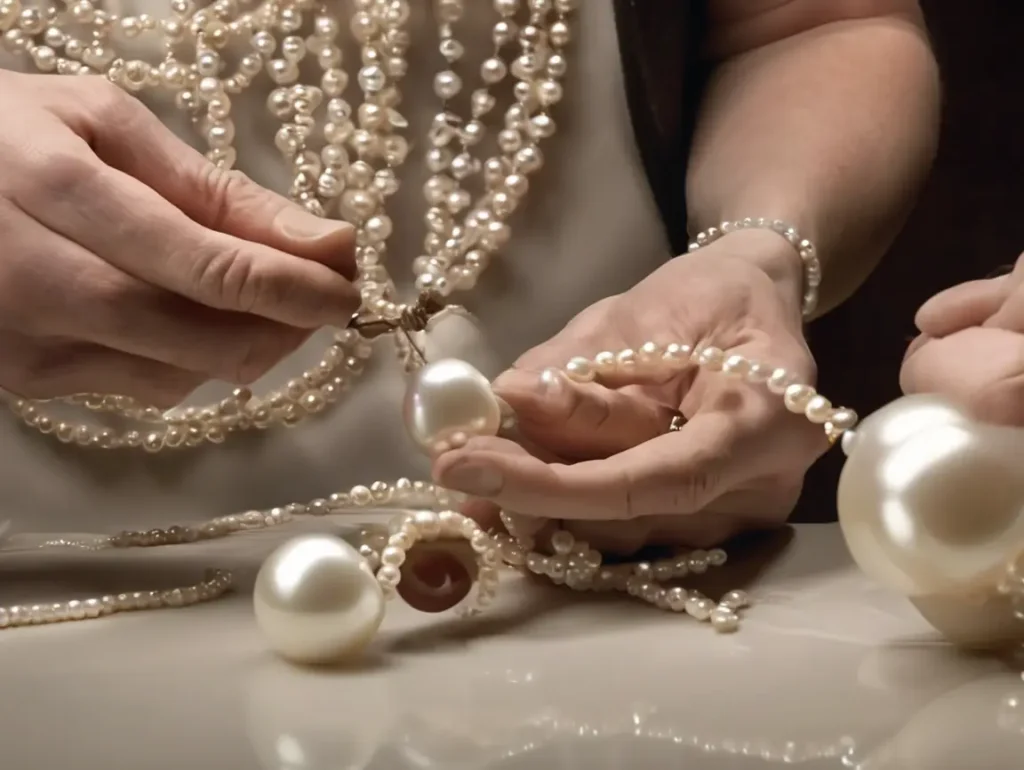
Let’s face it—when your favorite pearl necklace snaps, it’s stressful. You might be tempted to take it to the nearest jewelry store and hope for the best.
But not all jewelers are created equal, especially when it comes to pearls restrung. Some jewelers specialize in repairs but have little experience with delicate, knotted strands.
Before entrusting something so personal, please feel free to ask any questions. What kind of thread will they use? Will they knot between each pearl? How will they make sure the necklace still fits and falls nicely on your neck?
A real expert won’t be annoyed—you’ll actually learn a lot from their answers. If they shrug or give vague replies, take that as your cue to walk away.
Ignoring Fit and Comfort: Your Necklace Shouldn’t Just Look Fixed—It Should Feel Right
You’ve probably worn that necklace for years, and without realizing it, the fit may have changed. Maybe it sits higher now, or the spacing feels tighter after years of wear.
Restringing gives you a chance to get it just right. When you’re getting your pearls restrung, it’s not just about putting the pieces back together.
It’s also about how it drapes across your collarbone, whether it lies flat, and if it’s too tight or too loose.
A few millimeters can change how confident you feel when you wear it. That’s why you should never skip a conversation about length and spacing. You deserve a strand that’s as comfortable as it is beautiful.
The Tiny Clasp Matters More Than You Think—Don’t Overlook It
It’s a small piece, but the clasp can make or break the necklace—literally. Imagine wearing your newly pearls restrung strand to an event and the clasp fails halfway through the night.
It happens more often than you’d think, especially with older or weakened hardware. So while your pearls are in the shop anyway, take a moment to upgrade the clasp if needed.
Ask the jeweler whether it’s secure, if it matches the design, and whether it’s built to last. A good clasp isn’t just functional; it keeps your necklace safe and wearable for years to come.
Holding On to Sentimental Details That No Longer Work
We get it—there’s emotional value tied to your jewelry. Maybe it was a gift from your grandmother or something your mom wore every Sunday.
However, it’s not necessary to preserve every worn-out detail. Getting your pearls restrung thoughtfully doesn’t erase the memory—it protects it.
A skilled jeweler can retain the vintage aesthetic while replacing thread that’s frayed or a unreliable clasp.
Think of it this way: would your loved one want you to keep wearing a piece that breaks easily? Or would they prefer that you make sure it’s strong enough to last for the next generation?
Preserving Beauty While Enhancing Strength
Craftsmanship That Respects the Original Look
When you get your pearls restrung, it’s not just a matter of repair—it’s an act of preservation. Many people worry that restringing might alter the necklace’s original flow or charm, and they’re right to care.
A properly restrung strand should look like nothing ever happened. If the pearls once draped elegantly across your neck, they should do exactly that again.
The necklace’s spacing, alignment, and curvature must stay as elegant as when you first wore it. That’s the real difference between a careless fix and a professional pearls restrung process—one restores more than thread; it restores memory and beauty.
The Balance Between Durability and Aesthetics
Some jewelers focus only on making the necklace hold together again, using strong thread or tight knots—but forget that aesthetics matter just as much.
A well-executed pearls restrung service finds the sweet spot between resilience and elegance. The knots should be invisible to the eye but strong enough to last.
The pearls should roll smoothly along your collarbone without any stiffness or gaps. You don’t want something that looks stiff or artificial; you want the soul of the necklace to come back to life.
That’s what happens when someone takes time to study your piece before starting the pearls restrung process. It becomes clear they’re not just fixing jewelry—they’re curating a legacy.
Knots, Length, and the Flow of the Strand
The beauty of pearls lies not just in their luster but in how they sit and move. When your pearls restrung job includes precise knotting, correct length, and careful placement, the necklace becomes wearable art.
Instantly, you’ll notice the difference—the necklace lays better, feels smoother, and moves as if crafted specifically for you, thanks to its professional restrung process.
That’s the beauty of working with someone who cares about both form and function. In fact, many clients say they didn’t realize how uncomfortable their necklace had become until they had their pearls restrung professionally. Suddenly, the strand moves differently. It breathes again.
If you originally strung your pearls decades ago, it’s likely that they didn’t reflect your current preferences. Having your pearls restrung isn’t just about restoring what was—it’s about updating it to fit your present lifestyle, taste, and wearability.
Whether you’re wearing the necklace daily or saving it for special occasions, how it feels on you matters. The right tension in the thread, the right number of knots, and the right weight distribution all contribute to your comfort and confidence.
Finding Joy in the Details
There’s something deeply satisfying about running your fingers over a newly pearls restrung strand and feeling the even tension, the clean transitions, and the elegant fall of each pearl.
That sensation isn’t accidental. It’s built through years of experience, attention to microscopic spacing, and a true respect for the material. The goal isn’t perfection—it’s connection.
When your pearls are restrung with care, you reconnect with the story behind them, whether they were a gift, an inheritance, or something you bought to celebrate yourself.
So, if you’re thinking of having your pearls restrung, don’t see it as a mere repair. See it as an upgrade to the way your pearls live and move with you.
Done right, you won’t just restore beauty—you’ll enhance it.
When Restringing Is More Than Just Maintenance
Emotional value is hidden in every strand.
Jewelry, especially pearls, is rarely just decoration. It’s often a memory you wear. That necklace may have been passed down through generations or gifted on an unforgettable anniversary.
So, when a strand breaks or loosens, it feels like more than just a repair job—it feels personal. This is why having your pearls restrung by someone who recognizes the emotional significance is essential.
They’re not just handling beads and thread; they’re handling pieces of your story. Sloppy work can ruin the look of your necklace and the sentimental value you place on it.
Trust Is Earned, Not Assumed
The mistake many people make is that they assume any jeweler can handle delicate pearl work. But not all craftspeople approach pearls restrung work with the same care.
Some may overlook the nuances—like matching knot tension, spacing for pearl size, or the drape of the necklace. What is the final product?
Technically, the strand remains intact, yet it no longer resonates as “yours”.
The right expert doesn’t just fix things—they restore them to feel as personal and meaningful as they did before. Frequently, they enhance its quality.
If you’ve ever experienced the disappointment of having a treasured necklace returned to you looking different—stiffer, shorter, or somehow “off”—then you understand how critical it is to choose wisely.
A jeweler who specializes in pearls restrung projects won’t just hand you back a strand; they’ll give you back a feeling, a memory, a piece of identity that felt momentarily lost.
More Than Repair: It’s a Reconnection
When clients walk into a workshop with broken pearls, they often carry a quiet sense of guilt or regret—like they let something important fall apart. What they need, more than anything, is assurance that this is not the end of the story.
The pearls restrung process becomes a bridge—not only between broken and whole but between past and present. It’s a chance to reconnect with the sentiment, to breathe new life into something that still has value.
Whether it’s your grandmother’s strand or something you bought for yourself during a moment of joy, the act of having your pearls restrung is deeply personal.
And when it’s done right, you don’t just walk away with a fixed necklace—you walk away with something that feels cherished again.
That’s the power of craftsmanship paired with empathy. It’s why the best restringing jobs feel invisible, yet transformative.
Frequently Asked Questions About Pearls Restrung
How Often Should I Have My Pearls Restrung?
Most experts recommend having your pearls restrung every one to two years, especially if you wear them frequently. Natural silk thread weakens over time, particularly if the pearls are exposed to sweat, oils, or perfume.
If the strand starts to look loose or the knots begin to shift, it’s time to visit a professional.
Can I Wear My Pearls Every Day After Restringing?
Yes, but with care. After your pearls restrung service is complete, your necklace is ready to wear—but avoid contact with water, perfumes, or lotions.
These substances can degrade both the thread and the nacre over time. Daily wear is fine as long as you handle the pearls gently and store them in a soft pouch.
Is Knotting Between Each Pearl Necessary?
Absolutely. Knotting helps prevent the pearls from rubbing against each other, which protects the nacre. In the event your pearls restrung strand breaks, the knots also keep pearls from scattering.
It’s a key part of any professional restringing service and is often a sign of high-quality craftsmanship.
What Thread Is Used for Restringing Pearls?
Traditionally, we use natural silk due to its soft drape and ease of knotting. However, newer synthetic threads are also available for those looking for extra durability.
A good pearls restrung provider will advise based on your wear habits and the size of your pearls.
Can I Restring Pearls at Home?
Technically, you can restring your pearls at home, but we don’t recommend it unless you have experience. DIY restringing can result in poor tension, improper knotting, or even damage to the pearls.
If your pearls restrung result matters to you—and it should—trust a jeweler who specializes in this craft.
Conclusion: Don’t Wait Until It’s Too Late
Getting your pearls restrung shouldn’t be a reaction to disaster. It should be a proactive part of caring for a piece of jewelry that holds meaning far beyond its price tag. Waiting too long increases the likelihood of a break occurring at the most inconvenient time. And when that happens, you risk losing more than just a bead or two—you lose a connection.
Restringing is more than repair. It’s preservation, transformation, and even emotional restoration. The next time your pearls feel loose, or if you’ve been putting off that appointment, remember: having your pearls restrung is one of the simplest ways to honor your past and keep it with you—securely, beautifully, and comfortably.
Don’t let your necklace break before you act. Give your pearls the care they deserve—because what they represent is too important to lose.

